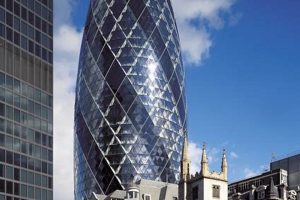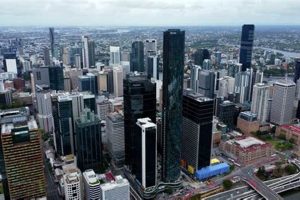Office skyscrapers are prevalent in major cities around the world, reshaping skylines and transforming the way we work. These towering structures offer a multitude of advantages that make them a significant aspect of modern business and urban development.
One of the primary benefits of office skyscrapers is their ability to accommodate a large number of employees in a relatively small footprint. By building upwards, businesses can maximize space utilization and create efficient work environments. Skyscrapers also provide ample natural light, which has been shown to improve employee productivity, well-being, and overall job satisfaction.
Moreover, office skyscrapers are often equipped with state-of-the-art infrastructure and amenities, such as high-speed elevators, advanced security systems, and sophisticated telecommunications networks. These features enhance connectivity, streamline operations, and foster a sense of prestige and professionalism among tenants.
From an urban planning perspective, office skyscrapers contribute to the economic vitality and sustainability of cities. They act as hubs for commerce, finance, and innovation, attracting businesses and talent from around the world. Additionally, by concentrating office space in vertical structures, skyscrapers help reduce urban sprawl, preserve green spaces, and promote walkability.
Furthermore, office skyscrapers serve as architectural landmarks and symbols of urban progress. Their iconic designs and impressive heights captivate the imagination and create a sense of place in the cities they inhabit. They are often associated with power, ambition, and the drive for success.
In conclusion, office skyscrapers play a crucial role in modern business and urban development. Their ability to accommodate large numbers of employees, provide efficient work environments, offer advanced amenities, contribute to urban vitality, and serve as architectural landmarks makes them an essential part of the contemporary cityscape.
1. Space Optimization
Space optimization is a crucial factor contributing to the significance of office skyscrapers. By building upwards instead of outwards, skyscrapers enable businesses to accommodate a substantial number of employees within a limited urban footprint. This vertical construction strategy maximizes land use efficiency, particularly valuable in densely populated cities where land is scarce and expensive.
Real estate costs represent a significant expense for businesses, and skyscrapers help minimize these costs by optimizing space. By stacking office floors vertically, businesses can reduce their overall rental or purchase expenses compared to sprawling single-story buildings. The compact design of skyscrapers also allows for efficient use of common areas, such as lobbies, elevators, and restrooms, further maximizing space utilization.
Moreover, space optimization in skyscrapers translates to greater operational efficiency for businesses. Employees can easily move between departments and collaborate with colleagues located on different floors, fostering better communication and teamwork. The vertical arrangement also reduces the need for extensive horizontal movement, saving time and improving productivity.
In conclusion, space optimization is a fundamental reason why office skyscrapers are important. By maximizing space utilization, skyscrapers enable businesses to accommodate more employees in a smaller footprint, reduce real estate costs, and enhance operational efficiency. This efficient use of space is essential for businesses to thrive in competitive urban environments and drive economic growth.
2. Natural Light
Natural light is a crucial element that enhances the importance of office skyscrapers. Ample natural light in these buildings contributes significantly to employee productivity, well-being, and overall job satisfaction.
- Improved Productivity: Studies have shown that natural light in the workplace boosts employee productivity by up to 20%. The full-spectrum light from the sun enhances alertness, reduces eye strain, and improves cognitive function, leading to increased focus and efficiency.
- Enhanced Well-being: Natural light has a positive impact on employee well-being. It helps regulate circadian rhythms, reducing fatigue and improving sleep quality. Additionally, exposure to natural light reduces stress levels, promotes a sense of calm, and improves overall mood.
- Increased Job Satisfaction: Ample natural light in the workplace has been linked to higher levels of employee satisfaction. Employees in naturally lit offices report greater comfort, reduced instances of headaches and eye problems, and an overall improved work environment, leading to increased job satisfaction and employee retention.
- Sustainable Design: Maximizing natural light in skyscrapers is not only beneficial for employees but also contributes to sustainable building design. By reducing the reliance on artificial lighting, skyscrapers can conserve energy and reduce their carbon footprint, aligning with current environmental goals.
In conclusion, the abundance of natural light in office skyscrapers plays a vital role in enhancing employee productivity, well-being, and job satisfaction. By providing access to natural light, skyscrapers create healthier and more productive work environments, contributing to the overall importance of these buildings in modern urban development.
3. Advanced Infrastructure
Advanced infrastructure and amenities are integral to the importance of office skyscrapers, enabling businesses to operate efficiently, enhance employee productivity, and project a positive image.
- Enhanced Connectivity: Skyscrapers are equipped with high-speed internet, fiber optic cables, and advanced telecommunications networks. This connectivity allows businesses to seamlessly share information, collaborate with remote teams, and access cloud-based services, fostering innovation and productivity.
- Streamlined Operations: State-of-the-art infrastructure, such as smart building systems, automated elevators, and efficient HVAC systems, helps businesses streamline their operations. These systems optimize energy usage, reduce maintenance costs, and create a comfortable and productive work environment.
- Prestige and Image: Office skyscrapers, with their iconic designs and impressive heights, convey a sense of prestige and success. This can attract top talent, boost employee morale, and enhance a company’s
reputation among clients and partners. - Sustainability: Advanced infrastructure can contribute to sustainability efforts. Energy-efficient lighting, rainwater harvesting systems, and green building materials reduce a skyscraper’s environmental impact, aligning with corporate social responsibility goals and promoting a sustainable urban environment.
In conclusion, the advanced infrastructure and amenities found in office skyscrapers are essential for businesses to thrive in today’s competitive market. They enhance connectivity, streamline operations, foster prestige, and contribute to sustainability, solidifying the importance of skyscrapers in modern urban development.
4. Urban Vitality
The concentration of office space in skyscrapers plays a pivotal role in promoting urban vitality and sustainability. By building upwards instead of outwards, skyscrapers reduce urban sprawl, preserve green spaces, and encourage walkability, contributing to a more livable and sustainable urban environment.
Urban sprawl, characterized by the unchecked expansion of cities into surrounding areas, has detrimental effects on the environment and quality of life. Sprawling cities consume vast amounts of land, fragment ecosystems, and increase transportation emissions. Skyscrapers, by accommodating a large number of employees in a compact vertical structure, help curb urban sprawl and promote denser, more efficient urban development.
Furthermore, skyscrapers contribute to preserving green spaces by reducing the need for land-consuming single-story office buildings. The concentration of office space in vertical structures allows cities to preserve parks, greenways, and other natural areas that provide recreational opportunities, improve air quality, and mitigate the urban heat island effect.
Additionally, skyscrapers promote walkability by encouraging the development of mixed-use neighborhoods where residential, commercial, and office spaces are integrated. By locating offices in close proximity to other amenities, such as retail stores, restaurants, and public transportation, skyscrapers reduce the need for car ownership and promote a more walkable and sustainable lifestyle.
In conclusion, the concentration of office space in skyscrapers is a key factor in promoting urban vitality. By reducing urban sprawl, preserving green spaces, and promoting walkability, skyscrapers create more livable and sustainable cities. This understanding is essential for urban planners and policymakers seeking to a sustainable and thriving urban environment.
5. Economic Hubs
Office skyscrapers are pivotal in driving economic growth and innovation by serving as hubs for commerce, finance, and innovation. These towering structures attract businesses and talent from around the world, creating a vibrant and dynamic urban ecosystem.
The concentration of businesses in skyscrapers fosters collaboration, knowledge sharing, and access to a diverse talent pool. This environment stimulates innovation, leading to the development of new products, services, and technologies. The presence of financial institutions in skyscrapers facilitates investment, funding, and capital raising, providing the necessary support for businesses to thrive.
Real-life examples abound. The financial district of London, anchored by skyscrapers like the Gherkin and the Shard, is a global hub for banking and finance. Similarly, the skyscrapers of Silicon Valley in California have fostered a thriving ecosystem for technology and innovation, attracting top talent and driving economic growth.
Understanding the role of office skyscrapers as economic hubs is crucial for urban planners, policymakers, and business leaders. By creating environments that attract and retain businesses and talent, cities can drive economic prosperity and innovation.
6. Architectural Landmarks
Skyscrapers, with their iconic designs and impressive heights, transcend their functional purpose and become architectural landmarks that embody urban progress and ambition. This symbolic significance is deeply intertwined with “why are offices skyscrapers important” and further enhances their overall value and impact.
As symbols of urban progress, skyscrapers reflect a city’s economic prosperity, technological advancements, and architectural prowess. They serve as physical manifestations of a city’s aspirations and its drive to innovate and grow. The Burj Khalifa in Dubai, the tallest building in the world, stands as a testament to human ingenuity and the relentless pursuit of architectural excellence.
Moreover, the ambition embedded in skyscrapers inspires and motivates. Their towering presence serves as a constant reminder of the human capacity for achievement and the power of collaboration. The Empire State Building in New York City, an iconic Art Deco masterpiece, continues to captivate and inspire generations with its grandeur and timeless design.
Understanding the connection between architectural landmarks and the importance of office skyscrapers is crucial for urban planners, architects, and business leaders. By embracing the symbolic power of skyscrapers, cities can create a built environment that fosters innovation, attracts investment, and enhances civic pride. Iconic skyscrapers serve as beacons of progress, shaping the identity of cities and leaving a lasting legacy for future generations.
7. Sustainability
The pursuit of sustainability is inextricably linked to the importance of office skyscrapers. Vertical construction, a defining characteristic of skyscrapers, offers significant environmental advantages over sprawling single-story buildings.
Skyscrapers, by concentrating office space in a compact vertical structure, minimize urban sprawl and preserve natural habitats. Sprawling single-story buildings, on the other hand, consume vast amounts of land and contribute to deforestation, habitat fragmentation, and ecosystem degradation.
Furthermore, skyscrapers promote energy efficiency and reduced carbon emissions. Their compact design and the use of energy-efficient technologies, such as double-paned windows and LED lighting, minimize energy consumption. In contrast, single-story buildings often have a larger surface area exposed to the elements, leading to higher energy demands for heating and cooling.
Real-life examples showcase the environmental benefits of skyscrapers. The Bank of America Tower in New York City, for instance, is designed to be LEED Platinum certified, incorporating sustainable features such as rainwater harvesting, solar panels, and a green roof. The Burj Khalifa in Dubai utilizes double-skin facades and advanced HVAC systems to reduce energy consumption by 40%.
The understanding of sustainability as a key component of skyscraper importance is crucial for architects, urban planners, and business leaders. By embracing sustainable practices in skyscraper design and construction, we can create bu
ilt environments that minimize environmental impact and contribute to the well-being of future generations.
FAQs on “Why Are Offices Skyscrapers Important?”
This section provides concise answers to frequently asked questions regarding the significance of office skyscrapers, dispelling common misconceptions and highlighting their multifaceted importance.
Question 1: Why are offices built as skyscrapers instead of single-story buildings?
Skyscrapers maximize space utilization, allowing for a large number of employees to be accommodated in a compact footprint. This vertical construction strategy optimizes land use and reduces urban sprawl, preserving green spaces and promoting walkability.
Question 2: How do skyscrapers benefit employees?
Skyscrapers provide ample natural light, which has been shown to enhance productivity, well-being, and job satisfaction. Advanced infrastructure and amenities, such as high-speed internet and efficient HVAC systems, streamline operations and foster a comfortable and productive work environment.
Question 3: What are the economic advantages of office skyscrapers?
Skyscrapers act as hubs for commerce, finance, and innovation, attracting businesses and talent from around the world. They facilitate collaboration, knowledge sharing, and access to capital, driving economic growth and prosperity.
Question 4: How do skyscrapers contribute to urban development?
Skyscrapers promote urban vitality by concentrating office space in vertical structures, reducing urban sprawl, and preserving green spaces. They encourage mixed-use neighborhoods and promote walkability, creating more livable and sustainable urban environments.
Question 5: Are skyscrapers environmentally sustainable?
Vertical construction minimizes urban sprawl and preserves natural habitats. Skyscrapers employ energy-efficient technologies and sustainable design principles, reducing carbon emissions and promoting environmental stewardship.
Question 6: How do skyscrapers represent architectural innovation and ambition?
Skyscrapers, with their iconic designs and impressive heights, serve as architectural landmarks that embody urban progress and ambition. They inspire creativity, symbolize economic prosperity, and leave a lasting legacy on the skylines of cities worldwide.
In conclusion, office skyscrapers are important due to their ability to optimize space, provide efficient and healthy work environments, contribute to economic vitality, promote sustainable urban development, and serve as architectural icons. Their multifaceted significance makes them a crucial element of modern urban landscapes.
Transition to the next article section: Exploring the Future of Office Skyscrapers
Tips on the Importance of Office Skyscrapers
Office skyscrapers play a crucial role in urban development and economic growth. Here are a few key tips to consider:
Tip 1: Optimize Space UtilizationSkyscrapers maximize space utilization, allowing businesses to accommodate more employees in a smaller footprint. This vertical construction strategy optimizes land use and reduces urban sprawl, preserving green spaces and promoting walkability.Tip 2: Enhance Employee Well-beingAmple natural light in skyscrapers has been shown to improve employee productivity, well-being, and job satisfaction. Advanced infrastructure and amenities, such as high-speed internet and efficient HVAC systems, streamline operations and foster a comfortable and productive work environment.Tip 3: Drive Economic GrowthSkyscrapers act as hubs for commerce, finance, and innovation, attracting businesses and talent from around the world. They facilitate collaboration, knowledge sharing, and access to capital, driving economic growth and prosperity.Tip 4: Promote Urban VitalitySkyscrapers concentrate office space in vertical structures, reducing urban sprawl and preserving green spaces. They encourage mixed-use neighborhoods and promote walkability, creating more livable and sustainable urban environments.Tip 5: Embrace Sustainable DesignSkyscrapers can be designed and constructed to minimize environmental impact. Vertical construction reduces urban sprawl and preserves natural habitats. Energy-efficient technologies and sustainable design principles can reduce carbon emissions and promote environmental stewardship.Summary:By embracing the importance of office skyscrapers and incorporating these tips into urban planning and architectural design, cities can create more sustainable, vibrant, and economically prosperous communities.
Transition to the article’s conclusion: Office skyscrapers will continue to play a vital role in shaping the future of cities, providing efficient and sustainable workspaces that foster innovation, economic growth, and urban vitality.
Conclusion
In conclusion, office skyscrapers remain a cornerstone of modern urban development and economic growth. Their ability to optimize space, provide efficient and healthy work environments, contribute to economic vitality, promote sustainable urban development, and serve as architectural icons makes them an essential part of the urban landscape.
As cities continue to evolve, the role of office skyscrapers will only become more critical. By embracing innovative design and sustainable practices, we can create skyscrapers that meet the needs of businesses and employees while contributing to the overall well-being of our communities. Office skyscrapers will continue to shape the skylines of cities worldwide, serving as symbols of progress and prosperity for generations to come.







